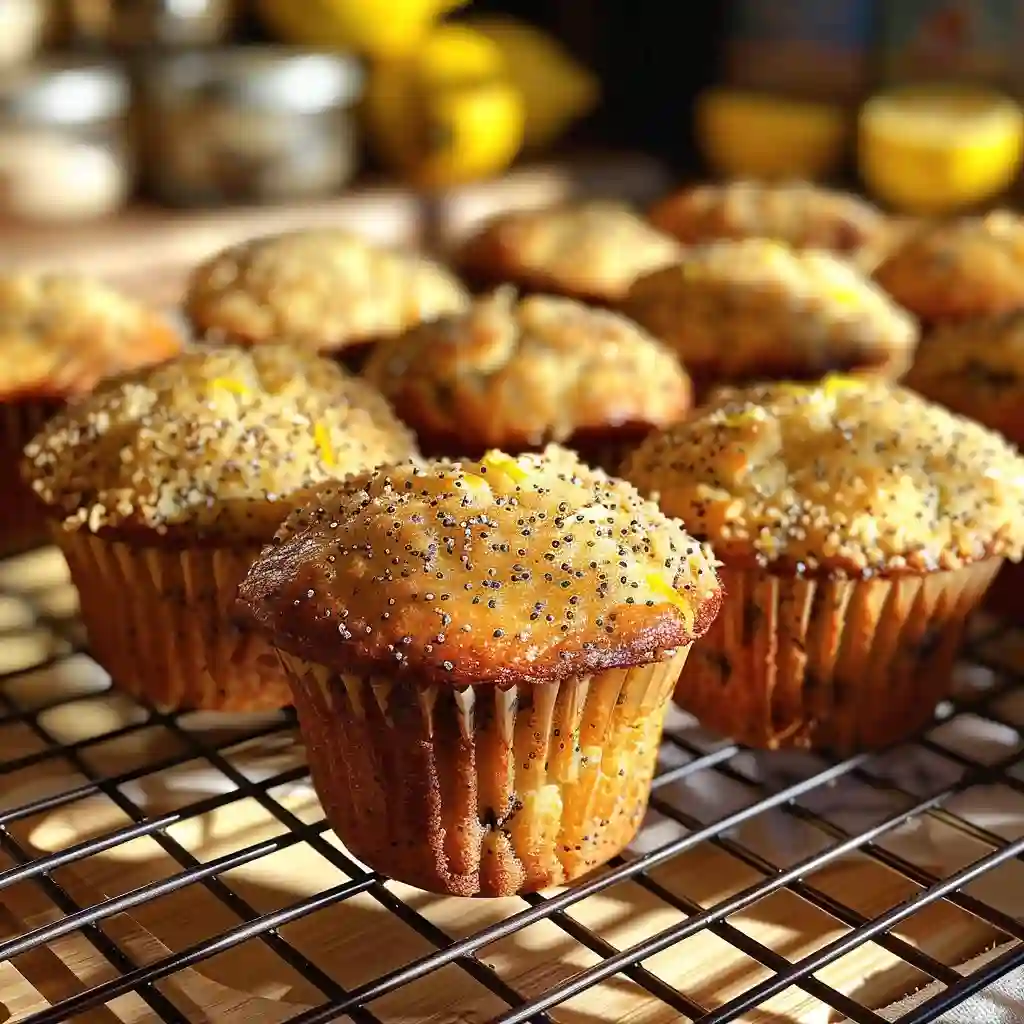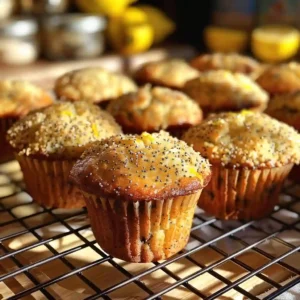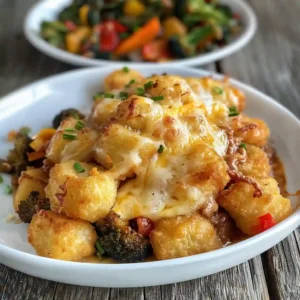High-Protein Lemon Poppy Seed Muffins are one of my favorite kitchen discoveries, and I can’t wait to share why they’ve become a staple in my family’s weekly meal prep. As a busy dad trying to eat healthier without compromising on taste or convenience, I’ve tested dozens of muffin recipes—but none hit the mark quite like these. They pack a punch of protein, deliver that zesty lemon brightness I love, and have just the right crunch from poppy seeds. Best of all, they fit perfectly into a high-protein, low-sugar lifestyle, making them a smart option for breakfast, snack time, or even dessert.
If you’re a muffin fan like me, you’ll also love these easy banana cottage cheese muffins—a simple, high-protein treat that helped me perfect my approach to healthy baking.
In this article, I’m going to walk you through everything you need to know about making and enjoying high-protein lemon poppy seed muffins at home. From ingredients to nutrition tips, protein powder swaps, storage tricks, and expert baking techniques, I’ve got you covered. I’ll even break down some frequently asked questions and give you a clear look at how to get the best texture and flavor every single time.
Get ready to make a batch that’s packed with protein, family-approved, and bursting with fresh lemon flavor.
Table of Contents
Benefits of High-Protein Lemon Poppy Seed Muffins
Why High-Protein Muffins Are a Game-Changer
As a dad juggling work and family, I used to skip breakfast or grab sugar-filled pastries just to get by. But when I discovered how easy it is to make high-protein lemon poppy seed muffins, everything changed. These muffins don’t just taste good—they help keep you full longer, balance blood sugar levels, and support muscle recovery after workouts. Instead of crashing mid-morning, I feel energized and focused until lunch. That’s the power of protein-rich baking.
Nutritional Profile: What Makes Them “High-Protein”?
To call a muffin high-protein, it needs a meaningful boost from ingredients like Greek yogurt, almond flour, cottage cheese, or protein powder. Most standard lemon poppy seed muffins have 3–5 grams of protein per serving—but mine easily double that. Here’s a quick breakdown of what one of my muffins usually offers:
That’s a balanced snack that actually works for your goals. Whether you’re trying to stay lean, build muscle, or just avoid the 3 PM crash, high-protein muffins are a convenient solution.
Print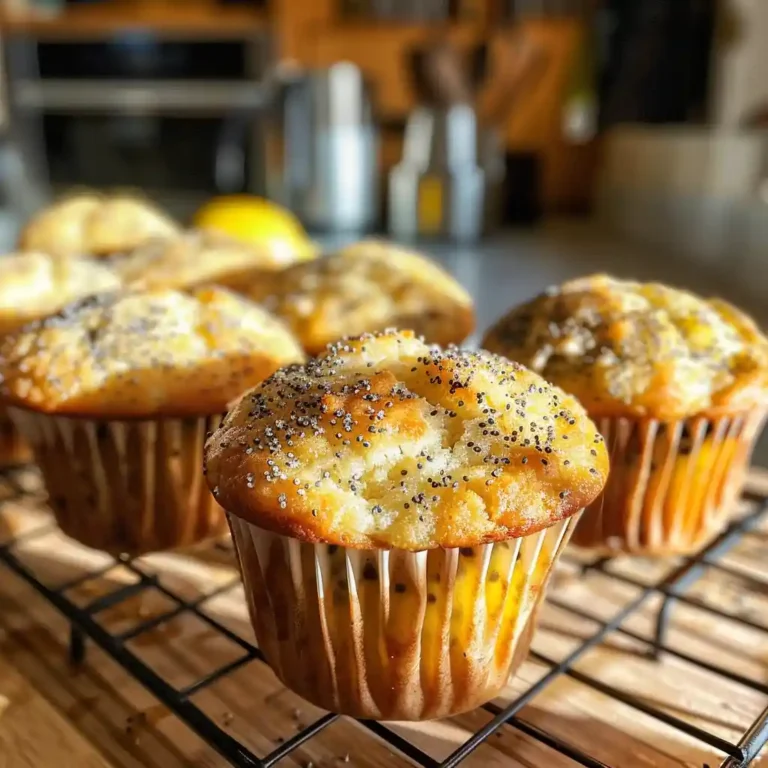
High-Protein Lemon Poppy Seed Muffins (Dairy-Free, Meal Prep Friendly)
These high-protein lemon poppy seed muffins are moist, fluffy, and zesty, packed with natural protein sources like Greek yogurt, eggs, and almond flour. Ideal for a nutritious breakfast or snack!
- Total Time: 30 minutes
- Yield: 12 muffins 1x
Ingredients
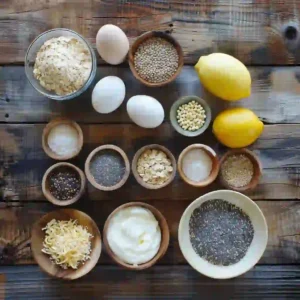
1 cup Greek yogurt (plain, non-fat or 2%)
- 2 eggs + 1 egg white
- 1/3 cup honey or maple syrup
- Juice and zest from 2 lemons
- 1 tsp vanilla extract
- 1 cup oat flour
- 1/2 cup almond flour
- 1/2 cup whey or plant protein powder
- 1 ½ tsp baking powder
- Pinch of salt
- 1.5 tbsp poppy seeds
Instructions
- Preheat the oven to 350°F (175°C) and line a muffin tin with parchment liners or spray lightly with oil.
- In a large bowl, whisk Greek yogurt, eggs, egg white, honey or maple syrup, lemon juice and zest, and vanilla extract.
- In another bowl, stir together oat flour, almond flour, protein powder, baking powder, salt, and poppy seeds.
- Slowly fold the dry ingredients into the wet mixture. Don’t overmix.
- Scoop the batter evenly into 10–12 muffin cups.
- Bake for 18–22 minutes, or until a toothpick comes out clean.
- Let muffins rest for 5–10 minutes before serving.
Notes
Use room temperature ingredients and don’t overbake to keep muffins moist. Resting the batter before baking helps with rise and texture.
- Prep Time: 10 minutes
- Cook Time: 20 minutes
- Category: Breakfast
- Method: Baking
- Cuisine: American
Nutrition
- Serving Size: 1 muffin
- Calories: 180
- Sugar: 6g
- Sodium: 90mg
- Fat: 7g
- Saturated Fat: 1g
- Unsaturated Fat: 5g
- Trans Fat: 0g
- Carbohydrates: 15g
- Fiber: 2g
- Protein: 10g
- Cholesterol: 35mg
Key Ingredients for High-Protein Lemon Poppy Seed Muffins
Protein-Rich Foundations: What to Use and Why
When I first started experimenting, I realized the key to a perfect batch of high-protein lemon poppy seed muffins was finding the right mix of protein without sacrificing that fluffy texture. I’ve tested every combo out there—here’s what actually works best:
- Greek Yogurt (Plain, Non-Fat or 2%): Adds moisture, tang, and 10–15g of protein per cup.
- Vanilla or Unflavored Whey Protein Powder: Blends seamlessly and offers a solid protein boost. Just don’t overdo it—too much can make the muffins dry.
- Eggs and Egg Whites: They bind the batter and support structure while adding natural protein.
- Almond Flour: Contributes healthy fats and a soft, delicate crumb, while boosting protein more than all-purpose flour.
- Rolled Oats or Oat Flour: A fiber-rich base that helps maintain shape and balances the muffin texture.
This balanced combination keeps your high-protein lemon poppy seed muffins from turning dense or rubbery—something I had to learn the hard way when testing with too much powder and not enough moisture.
If you’re curious about alternatives that don’t require protein powder, check out these high-protein chia recipes. They’re full of naturally nutrient-dense ideas that pair perfectly with your baking goals.
Lemon Zest + Poppy Seeds: Flavor and Function
Adding lemon zest isn’t just for taste—it brings that fresh, citrusy aroma that cuts through the richness and brightens the entire bite. I always zest two whole lemons for every batch to really elevate the flavor.
And let’s talk poppy seeds. You only need 1–2 tablespoons, but they do more than just add crunch:
- They offer small doses of fiber, calcium, and iron
- Their mild nuttiness balances out the lemon’s tartness
- They make your muffins visually pop with a unique, speckled texture
If you’ve ever wondered, “Why do we put poppy seeds in lemon muffins?”—this is exactly why. They deliver both character and nutrition in every bite.
When I make high-protein lemon poppy seed muffins, these are the non-negotiables for getting the taste and texture just right.
How to Make the Best High-Protein Lemon Poppy Seed Muffins
Step-by-Step Baking Instructions
After testing dozens of versions, I’ve finally landed on a simple method that delivers perfect high-protein lemon poppy seed muffins every time—moist, protein-packed, and bursting with lemon flavor in every bite.
Preheat the Oven
Set your oven to 350°F (175°C) and line a muffin tin with parchment liners or spray lightly with oil.
Mix the Wet Ingredients
In a large bowl, whisk:
- 1 cup Greek yogurt
- 2 eggs + 1 egg white
- 1/3 cup honey or maple syrup
- Juice and zest from 2 lemons
- 1 tsp vanilla extract
This forms your moist, flavorful base that sets the tone for your high-protein lemon poppy seed muffins.
Add the Dry Ingredients
In another bowl, stir together:
- 1 cup oat flour
- 1/2 cup almond flour
- 1/2 cup whey or plant protein powder
- 1 ½ tsp baking powder
- Pinch of salt
- 1.5 tbsp poppy seeds
Slowly fold the dry ingredients into the wet mixture. Don’t overmix or the muffins will get tough and chewy—something we want to avoid when aiming for perfect high-protein lemon poppy seed muffins.
Divide and Bake
Scoop the batter evenly into 10–12 muffin cups. Bake for 18–22 minutes, or until a toothpick inserted into the center comes out clean. The aroma of lemon and vanilla will let you know they’re nearly done.
Pro Tips for Texture and Rise
- Don’t overbake: Protein muffins dry out fast. Pull them the moment the centers are set for that tender bite.
- Rest the batter: Let it sit for 5–10 minutes before baking. This helps hydrate the flour and gives your high-protein lemon poppy seed muffins a more consistent rise.
- Use room temp ingredients: Everything blends better and rises more evenly when it’s not cold out of the fridge.
With a little care, you’ll end up with high-protein lemon poppy seed muffins that look and taste bakery-fresh—without the sugar crash.
Customizing Your Muffins for Any Diet
Gluten-Free and Dairy-Free Variations
One of the things I love most about high-protein lemon poppy seed muffins is how easily they adapt to different dietary needs. With a few smart swaps, you can make these muffins fit almost any lifestyle while still enjoying the same bright flavor and satisfying texture.
To make them gluten-free:
- Use certified gluten-free oat flour or a blend of almond flour and coconut flour.
- Double-check your baking powder is gluten-free (most are, but it’s worth confirming).
To make them dairy-free:
- Replace Greek yogurt with a thick plant-based yogurt (like coconut or almond).
- Use a dairy-free protein powder—pea protein works great but absorbs more liquid, so you may need to add almond milk.
To make them low-carb or keto-friendly:
- Sub oat flour for almond or sunflower seed flour.
- Use stevia, monk fruit, or erythritol instead of honey.
- Choose a zero-carb protein powder to reduce overall carbs.
For more inspiration on clean, protein-rich alternatives, check out these Ayurvedic high-protein recipes—they’re built around natural ingredients that balance energy and digestion.
No matter your dietary needs, these high-protein lemon poppy seed muffins can be adjusted without losing their flavor or fluffiness. It’s one of the reasons they’ve become a staple in our kitchen.
Fun Add-Ins for Extra Flavor and Texture
Sometimes, I get creative and throw in one or two mix-ins for variety—especially when the kids want something a little more exciting in their high-protein lemon poppy seed muffins.
Here are a few of our go-to additions:
- Chia seeds (1–2 tsp) for fiber and crunch
- Blueberries (¼ cup) for a fresh, juicy burst
- Crushed walnuts or almonds for healthy fat and texture
- Unsweetened coconut flakes for a tropical twist
- Collagen peptides to boost protein without changing flavor
Just don’t overload the batter. Stick to ½ cup or less of total add-ins per batch to avoid dense, soggy muffins. Keeping the texture right is key when customizing high-protein lemon poppy seed muffins, no matter what you toss in.
Storing and Meal Prepping High-Protein Muffins
How to Store for Freshness
When I bake a big batch of high-protein lemon poppy seed muffins, I want them to stay moist and tasty all week—because no one wants dry, rubbery muffins. Here’s how I keep them fresh:
- At Room Temperature: Store in an airtight container with a paper towel on top and bottom. Stays soft for 3 days.
- In the Fridge: Wrap individually in parchment, then seal in a container. Good for 6 days.
- Freezer Friendly: These freeze beautifully. Let them cool fully, then freeze in airtight bags for 2–3 months.
To thaw, just leave one out overnight or pop it in the microwave for 30–45 seconds.
Muffins as a Meal Prep Power Move
As a parent trying to simplify mornings, meal prep is my lifesaver. I usually bake a dozen on Sunday—half go in the fridge for quick breakfasts, the rest into the freezer for future grab-and-go options. Each muffin delivers a solid protein boost, especially when paired with fruit or a shake.
Here’s how I prep them efficiently:
- Mix dry ingredients ahead and store in a jar
- Make double batches and freeze half
- Use silicone liners for easy cleanup and portioning
Planning ahead with high-protein lemon poppy seed muffins saves time, reduces stress, and helps you stay on track with healthy eating. If you love having protein-ready meals on hand, you’ll also like these Mounjaro-friendly high-protein lunch ideas that keep energy steady all day.
Common Mistakes to Avoid with Protein Muffins
Overmixing the Batter
When I first started making high-protein lemon poppy seed muffins, I treated them like regular ones—but learned the hard way that overmixing is a real problem. With added protein powder, the batter can become gummy fast. To avoid dense muffins, mix until just combined. A few lumps are okay—they’ll bake out.
Using the Wrong Protein Powder
Not all protein powders are muffin-friendly. Some plant-based powders soak up too much moisture, while certain whey blends may leave a chalky aftertaste. Stick with:
- Whey isolate or concentrate for a smooth texture
- Pea protein (add more liquid as needed)
- Unflavored or vanilla protein to avoid overpowering lemon zest
Avoid casein or collagen as the main source—they don’t provide the structure needed for muffins to rise properly.
Skipping the Acid
Lemon juice does more than add flavor—it activates baking powder and helps the muffins rise. Don’t leave it out or sub with bottled lemon juice unless it’s fresh. The combo of lemon zest + juice is essential to balancing flavor and texture.
Overbaking
This mistake ruins even the best batter. High-protein lemon poppy seed muffins bake faster than traditional ones. The second they’re firm and a toothpick comes out clean, pull them. Leave them in too long, and you’ll be stuck with dry muffins no one wants to eat.
Best Protein Powders for Muffin Baking
Whey, Casein, Plant-Based – Which Is Best?
I’ve tested a lot of protein powders in muffins, and trust me—some work better than others. When baking high-protein lemon poppy seed muffins, I always look for one that adds structure without making the muffins rubbery or dry.
Here’s what I’ve learned:
- Whey Protein Isolate: My top pick. It blends smoothly, keeps muffins moist, and doesn’t overpower the lemon flavor.
- Whey Protein Concentrate: Slightly less refined than isolate, but still solid. May add a bit more richness.
- Plant-Based Protein: Works fine, especially pea or rice blends. You’ll need to add extra moisture (like applesauce or almond milk) to prevent drying.
- Casein Protein: Absorbs a ton of liquid—use sparingly or in a blend.
- Collagen Peptides: Great for extra protein but won’t give the muffin structure on its own. Best as a secondary addition.
Tips for Baking With Protein Powder
I used to think I could just scoop protein into any muffin recipe and it would work out. Big mistake. Here’s what I now follow for great results:
- Sub no more than 1/3 of the flour with protein powder
- Balance with moisture: Add more yogurt, applesauce, or almond milk
- Use baking powder generously: Helps counteract the weight of protein
- Test bake a single muffin before doing the full tray
These adjustments make a huge difference when working with high-protein lemon poppy seed muffins, especially if you’re experimenting with new powders.
Pairing and Serving Ideas for High-Protein Muffins
Easy Breakfast Combos
High-protein lemon poppy seed muffins are great on their own, but I’ve found a few combos that turn them into full meals without much effort:
- With a hard-boiled egg and fresh berries: Fast, balanced, and energizing
- Sliced and topped with Greek yogurt and chia seeds: Like a deconstructed parfait with extra texture
- Crumbled into a smoothie bowl: Adds chew and lemon zest to your morning smoothie
When I’m short on time (which is often), I grab a muffin and a protein shake—it’s a two-minute breakfast that keeps me going till lunch.
Looking for other creative pairings? Don’t miss our protein-packed blueberry coffee cake muffins—another zesty favorite that makes mornings more delicious.
Snack or Dessert Options
These muffins are more than just a morning meal. I often pack one in my gym bag or offer them as an after-school snack. They even double as a guilt-free dessert:
- Warm it up and spread almond butter or coconut cream on top
- Serve with a drizzle of honey and a sprinkle of toasted coconut
- Pair with herbal tea or a latte for a cozy evening treat
No matter how you serve them, high-protein lemon poppy seed muffins offer a delicious balance of taste and nutrition that fits right into your routine.
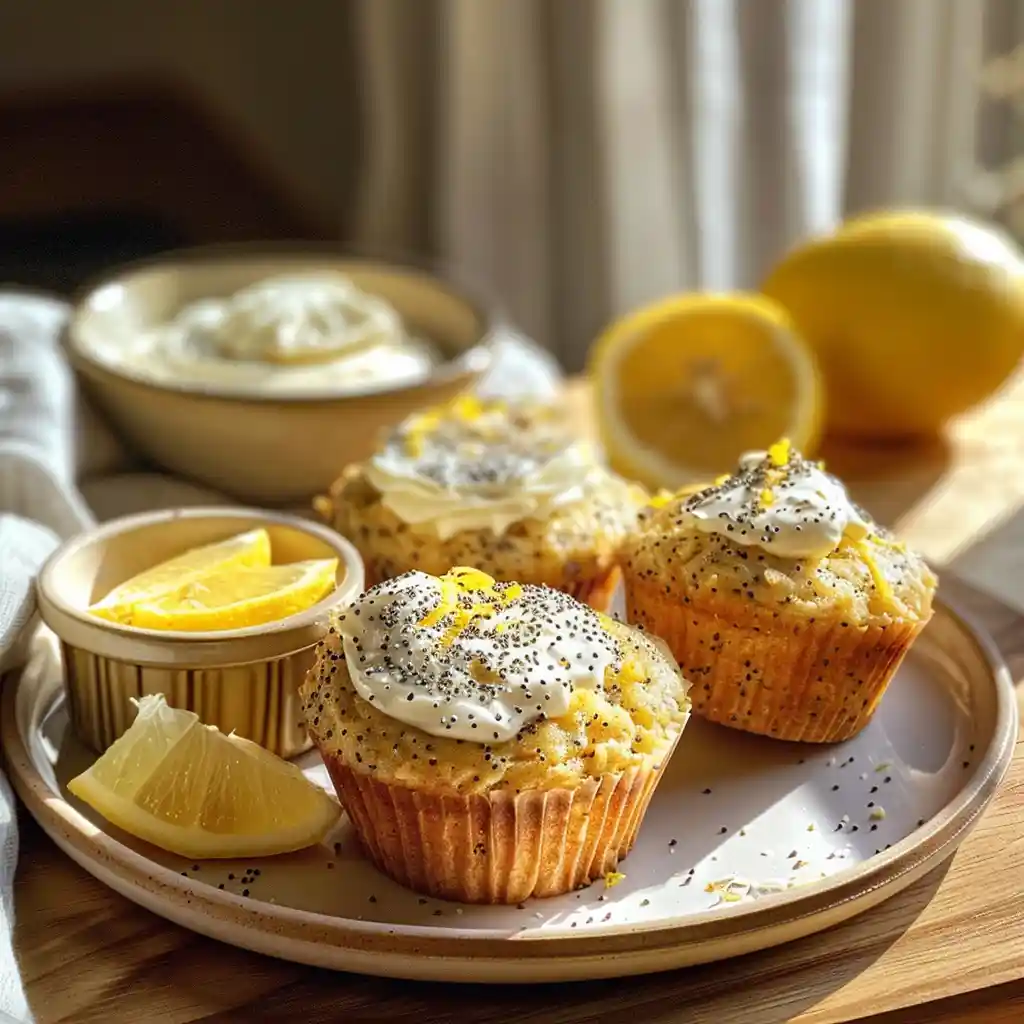
Why High-Protein Lemon Poppy Seed Muffins Are Worth Making
A Healthier Habit That Actually Sticks
Making high-protein lemon poppy seed muffins isn’t just about eating better—it’s about building small habits that support a busy life. These muffins have earned a regular spot in my weekly routine, not only because they taste great, but because they make eating well easy. They’re convenient, nutritious, and surprisingly filling without feeling heavy.
Whether I’m heading to a morning meeting or packing school lunches, having a batch of these on hand saves time—and energy. Best of all, they satisfy that craving for something sweet without wrecking my day.
Great for the Whole Family
What I love most about high-protein lemon poppy seed muffins is how well they work for everyone in the house. My kids are drawn to their bright lemony taste, while my wife appreciates that they’re lower in sugar than store-bought options. And for me, they’re the perfect balance of flavor, texture, and protein to keep me fueled between meals.
We bake them in batches, freeze what we don’t eat right away, and always have a healthy snack ready to go. It’s one of the few things we all agree on—because they truly taste like a treat.
If you’re looking to improve your family’s snacking habits—or your own—these muffins are a smart, satisfying step forward.
Frequently Asked Questions About High-Protein Lemon Poppy Seed Muffins
How much protein is in a lemon poppy seed muffin?
A standard muffin has about 3 to 5 grams of protein. But high-protein lemon poppy seed muffins can deliver 10 to 12 grams per serving, thanks to ingredients like Greek yogurt, eggs, and protein powder. That boost makes them a filling option that actually supports your nutrition goals.
Why do we put poppy seeds in lemon muffins?
Poppy seeds add more than just crunch—they bring a warm, nutty undertone that balances the tartness of lemon. Traditionally used in European baking, poppy seeds offer both flavor and texture, making every bite more interesting.
Can you add protein powder to boxed muffins?
You can, but it’s important to adjust other ingredients to keep the texture right. Try swapping out about a third of the mix with protein powder, and then add a little more moisture. Greek yogurt or a splash of milk works great. Don’t forget to slightly increase your leavening agent too.
Are poppy seed muffins good for you?
They can be! Traditional versions tend to be heavy on sugar and refined flour, but high-protein lemon poppy seed muffins use better ingredients—like oat flour, almond flour, and natural sweeteners—making them a great breakfast or snack option.
Conclusion: Start Baking Better with High-Protein Lemon Poppy Seed Muffins
If you’ve been searching for something that’s easy, healthy, and actually enjoyable, high-protein lemon poppy seed muffins check all the boxes. They’re vibrant, light, and surprisingly nourishing, with just the right amount of zest and sweetness to make you look forward to eating them.
These muffins work for any part of the day—whether it’s breakfast, post-workout, or an evening treat. They’re freezer-friendly, kid-approved, and simple to prepare. Most importantly, they make eating well feel effortless.
If you’re into wholesome, protein-rich treats, you might also love this soothing miso chia pudding or our selection of low histamine desserts designed to support hormonal balance with clean ingredients.
Want more inspiration and healthy snack ideas?
Follow me on Facebook for weekly recipe drops, and explore my boards on Pinterest where I share all my family favorites and protein-packed kitchen experiments!
